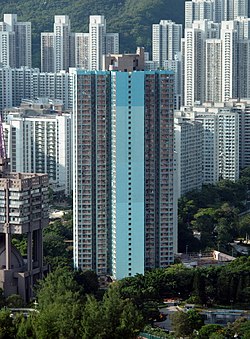Lok Fu Estate
| Lok Fu Estate | |
|---|---|
 | |
 | |
| General information | |
| Location | 198 Junction Road, Lok Fu Kowloon, Hong Kong |
| Coordinates | 22°20′10″N 114°11′12″E / 22.3361°N 114.1868°E |
| Status | Completed |
| Category | Public rental housing |
| Area | 12.2–57.7 m2 (131–621 ft2) |
| Population | 9,700 |
| No. of blocks | 11 |
| No. of units | 3,700 |
| Construction | |
| Constructed | 1957, 1961 (original), 1984 (current) |
| Authority | Hong Kong Housing Authority |
| Hong Keung Court | |
|---|---|
 | |
 | |
| General information | |
| Location | 23 Heng Lam Street, Lok Fu Kowloon, Hong Kong |
| Coordinates | 22°20′10″N 114°11′12″E / 22.3361°N 114.1868°E |
| Status | Completed |
| Category | Home Ownership Scheme court |
| Area | 53–80 m2 (570–860 sq ft2), 39–60 m2 (420–650 ft2) |
| No. of blocks | 1 |
| No. of units | 640 |
| Construction | |
| Constructed | 1999 |
| Authority | Hong Kong Housing Authority |
| Lok Fu Estate | |||||||||||||
|---|---|---|---|---|---|---|---|---|---|---|---|---|---|
| Traditional Chinese | 樂富邨 | ||||||||||||
| Simplified Chinese | 乐富邨 | ||||||||||||
| Cantonese Yale | lohk fu chyūn | ||||||||||||
| Literal meaning | music abundant estate | ||||||||||||
| |||||||||||||

Lok Fu Estate (Chinese: 樂富邨) is a public housing estate in Lok Fu, Wong Tai Sin District, Kowloon, Hong Kong, near Lok Fu station on the MTR.[1]
Hong Keung Court (康強苑) is a Home Ownership Scheme court near Lok Tung House, Lok Fu Estate. It has one block built in 1999.
History

Lok Fu Estate was formerly the Lo Fu Ngam Resettlement Area (老虎區徙置區) and has a total of 23 blocks, 12 Mark I type and 11 Mark II type, built in 1957.[2] As local residents found the name Lo Fu Ngam (Tiger Hill) inauspicious, the settlement was later renamed to Lok Fu (happy and prosperous).[3] A former shrine at the site was moved to a new location in Kwun Tong, which is now within the Tsui Ping Estate.[4] In 1973, the area was renamed the Lok Fu Estate.[5] It started rehabilitation and redevelopment in the 1980s. In 1991, the six blocks in the nearby Wang Tau Hom Estate were allocated to the Lok Fu Estate.[6]
Houses

Lok Fu Estate
| Name[7] | Type | Completion | Floors | Units per floor | Units |
|---|---|---|---|---|---|
| Wang Hong House | Old Slab (Special Edition) | 1984 | 17 | 42 (Floors 6 and 7), 38 (other floors) | 464 |
| Wang Lok House | 18 | 17 | 255 | ||
| Wang Shun House | 6 | 35 | 109 | ||
| Wang Tat House | 4 | 18 | 18 | ||
| Wang Yat House | 17 | 38 | 456 | ||
| Wang Yuk House | 1985 | 18 | 17 | 255 | |
| Lok Tung House | Linear 3 | 1989 | 24 | 20 | 523 |
| Lok Tai House | Harmony 1A with Harmony Annex 2 | 1995/1996 | 18 | 20 (without wing), 29 (with wing) | 469 |
| Lok Him House | Harmony 1A | 19 | 20 | ||
| Lok Tsui House | 19 | ||||
| Lok Man House | 24 |
Hong Keung Court
| Name[8] | Type | Completion | Floors | Units per floor | Units |
|---|---|---|---|---|---|
| Hong Keung Court | Harmony 1 | 1999 | 40 (Floors 1-40) | 16 | 640 |
Demographics
According to the 2016 by-census, Lok Fu Estate had a population of 9,952. The median age was 50.8 and the majority of residents (96.5 per cent) were of Chinese ethnicity. The average household comprised 2.7 persons. The median monthly household income of all households (i.e. including both economically active and inactive households) was HK$16,450.[9]
See also
References
- ^ Wong Tai Sin District Archived 2011-07-20 at the Wayback Machine
- ^ Wong Tai Sin District
- ^ Scott, Janet Lee (1982). "Structure And Function In An Urban Organization: The Mutual Aid Committees". Journal of the Royal Asiatic Society Hong Kong Branch. 22: 5. ISSN 0085-5774.
- ^ Myers, John T. (1975). "A Hong Kong Spirit-Medium Temple" (PDF). Journal of the Royal Asiatic Society Hong Kong Branch. 15: 16–27. ISSN 1991-7295.
- ^ 三十三年前的樂富邨 (Chinese Version)
- ^ 橫頭磡邨 (in Chinese)[permanent dead link]
- ^ Lok Fu Estate
- ^ Hong Keung Court
- ^ "Major Housing Estates". 2016 Population By-census. Census and Statistics Department. Retrieved 20 February 2020.
